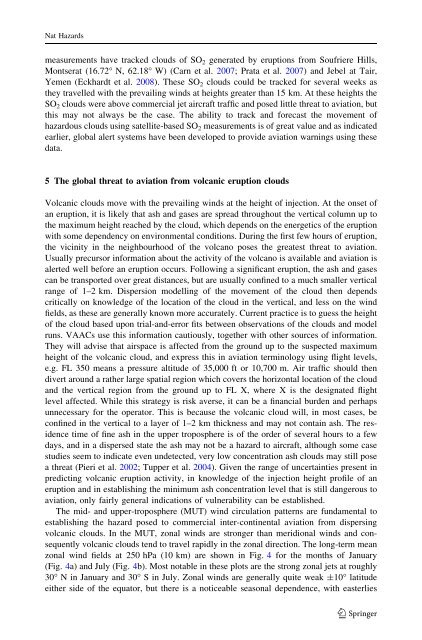Satellite detection of hazardous volcanic clouds and ... - Savaa - NILU
Satellite detection of hazardous volcanic clouds and ... - Savaa - NILU
Satellite detection of hazardous volcanic clouds and ... - Savaa - NILU
Create successful ePaper yourself
Turn your PDF publications into a flip-book with our unique Google optimized e-Paper software.
Nat Hazardsmeasurements have tracked <strong>clouds</strong> <strong>of</strong> SO 2 generated by eruptions from Soufriere Hills,Montserat (16.72° N, 62.18° W) (Carn et al. 2007; Prata et al. 2007) <strong>and</strong> Jebel at Tair,Yemen (Eckhardt et al. 2008). These SO 2 <strong>clouds</strong> could be tracked for several weeks asthey travelled with the prevailing winds at heights greater than 15 km. At these heights theSO 2 <strong>clouds</strong> were above commercial jet aircraft traffic <strong>and</strong> posed little threat to aviation, butthis may not always be the case. The ability to track <strong>and</strong> forecast the movement <strong>of</strong><strong>hazardous</strong> <strong>clouds</strong> using satellite-based SO 2 measurements is <strong>of</strong> great value <strong>and</strong> as indicatedearlier, global alert systems have been developed to provide aviation warnings using thesedata.5 The global threat to aviation from <strong>volcanic</strong> eruption <strong>clouds</strong>Volcanic <strong>clouds</strong> move with the prevailing winds at the height <strong>of</strong> injection. At the onset <strong>of</strong>an eruption, it is likely that ash <strong>and</strong> gases are spread throughout the vertical column up tothe maximum height reached by the cloud, which depends on the energetics <strong>of</strong> the eruptionwith some dependency on environmental conditions. During the first few hours <strong>of</strong> eruption,the vicinity in the neighbourhood <strong>of</strong> the volcano poses the greatest threat to aviation.Usually precursor information about the activity <strong>of</strong> the volcano is available <strong>and</strong> aviation isalerted well before an eruption occurs. Following a significant eruption, the ash <strong>and</strong> gasescan be transported over great distances, but are usually confined to a much smaller verticalrange <strong>of</strong> 1–2 km. Dispersion modelling <strong>of</strong> the movement <strong>of</strong> the cloud then dependscritically on knowledge <strong>of</strong> the location <strong>of</strong> the cloud in the vertical, <strong>and</strong> less on the windfields, as these are generally known more accurately. Current practice is to guess the height<strong>of</strong> the cloud based upon trial-<strong>and</strong>-error fits between observations <strong>of</strong> the <strong>clouds</strong> <strong>and</strong> modelruns. VAACs use this information cautiously, together with other sources <strong>of</strong> information.They will advise that airspace is affected from the ground up to the suspected maximumheight <strong>of</strong> the <strong>volcanic</strong> cloud, <strong>and</strong> express this in aviation terminology using flight levels,e.g. FL 350 means a pressure altitude <strong>of</strong> 35,000 ft or 10,700 m. Air traffic should thendivert around a rather large spatial region which covers the horizontal location <strong>of</strong> the cloud<strong>and</strong> the vertical region from the ground up to FL X, where X is the designated flightlevel affected. While this strategy is risk averse, it can be a financial burden <strong>and</strong> perhapsunnecessary for the operator. This is because the <strong>volcanic</strong> cloud will, in most cases, beconfined in the vertical to a layer <strong>of</strong> 1–2 km thickness <strong>and</strong> may not contain ash. The residencetime <strong>of</strong> fine ash in the upper troposphere is <strong>of</strong> the order <strong>of</strong> several hours to a fewdays, <strong>and</strong> in a dispersed state the ash may not be a hazard to aircraft, although some casestudies seem to indicate even undetected, very low concentration ash <strong>clouds</strong> may still posea threat (Pieri et al. 2002; Tupper et al. 2004). Given the range <strong>of</strong> uncertainties present inpredicting <strong>volcanic</strong> eruption activity, in knowledge <strong>of</strong> the injection height pr<strong>of</strong>ile <strong>of</strong> aneruption <strong>and</strong> in establishing the minimum ash concentration level that is still dangerous toaviation, only fairly general indications <strong>of</strong> vulnerability can be established.The mid- <strong>and</strong> upper-troposphere (MUT) wind circulation patterns are fundamental toestablishing the hazard posed to commercial inter-continental aviation from dispersing<strong>volcanic</strong> <strong>clouds</strong>. In the MUT, zonal winds are stronger than meridional winds <strong>and</strong> consequently<strong>volcanic</strong> <strong>clouds</strong> tend to travel rapidly in the zonal direction. The long-term meanzonal wind fields at 250 hPa (10 km) are shown in Fig. 4 for the months <strong>of</strong> January(Fig. 4a) <strong>and</strong> July (Fig. 4b). Most notable in these plots are the strong zonal jets at roughly30° N in January <strong>and</strong> 30° S in July. Zonal winds are generally quite weak ±10° latitudeeither side <strong>of</strong> the equator, but there is a noticeable seasonal dependence, with easterlies123
















